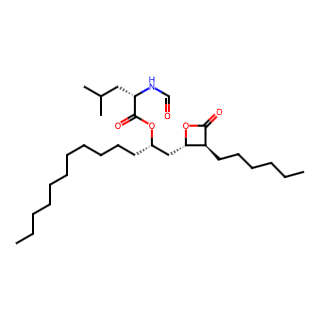- Synthetic anti-infective drugs
- Medications for the digestive system
- Antipyretic and analgesic drugs
- Medications for the blood system
- Medications for the respiratory system
- Anti-allergic drugs
- Medications for the urinary system
- Diagnostic medications
- Immunosuppressive and immunomodulatory drugs
- Vitamins and mineral supplements
- Antioxidants and medications for osteoporosis
- Antiparasitic drugs
- Ophthalmic medications
- Amino acids and their derivatives
- Dermatological medications
- Medications for the circulatory system
- Antitumor drugs
- Medications for the nervous system
- Hormonal and endocrine function-regulating drugs
- Antibiotics
- Others
CAS No.: 96829-58-2




English Name: Orlistat
Molecular Formula: C29H53NO5
Molecular Weight: 495.7 g/mol
CAS Number: 96829-58-2
Pharmacological Actions
1. Inhibition of Gastrointestinal Lipases: Orlistat acts as a potent and selective inhibitor of gastrointestinal lipases. By binding to the active sites of gastric and pancreatic lipases, it prevents these enzymes from hydrolyzing dietary triglycerides into absorbable free fatty acids and monoglycerides.
2. Reduction of Fat Absorption: As a result of lipase inhibition, less fat is absorbed in the intestine. This unabsorbed fat is excreted in the feces, leading to a caloric deficit which can contribute to weight loss.
3. Weight Management: Through its ability to reduce fat absorption, Orlistat aids in weight management and is often used as a therapeutic adjunct in the treatment of obesity, including weight loss and weight maintenance when used in conjunction with a reduced-calorie diet.
4. Improvement in Risk Factors: By aiding in weight loss, Orlistat can help improve several risk factors related to obesity, such as insulin resistance, elevated blood lipid levels, and reduced blood pressure.
5. Treatment of Hyperlipidemia: Orlistat has shown utility in contributing to the reduction of cholesterol levels and is sometimes used in the management of hyperlipidemia to improve overall lipid profiles.
6. Gastrointestinal Effects: Due to its mechanism of action, Orlistat may cause gastrointestinal side effects such as steatorrhea (fatty stools), fecal urgency, and oil spotting, which are typically dose-dependent and may reduce over time as the body adjusts to the medication.

Tai Yau Street, San Po Kong, Kowloon, Hong Kong, China.



